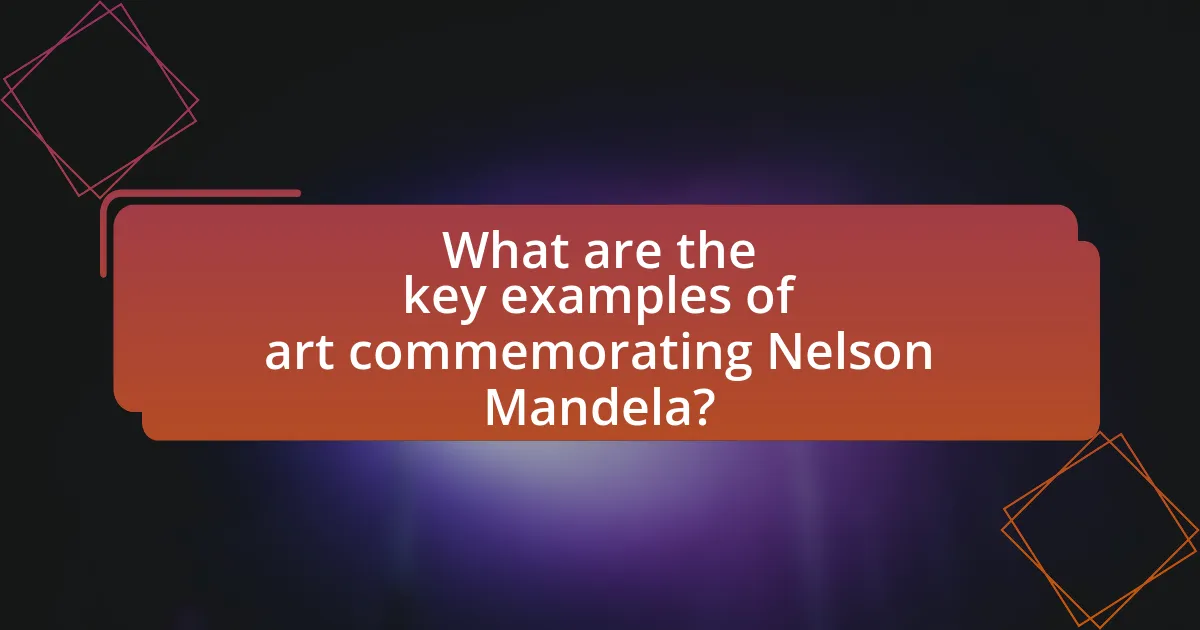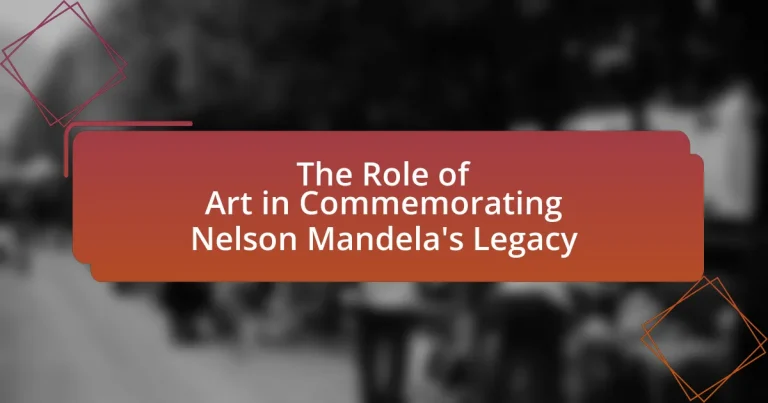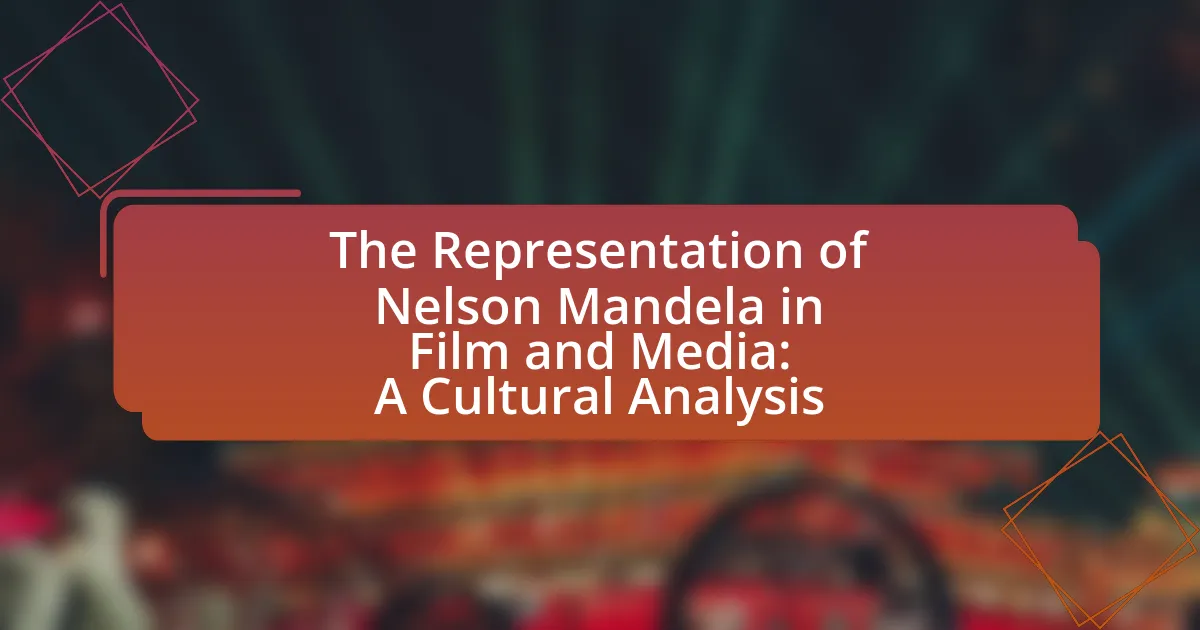The article examines the significant role of art in commemorating Nelson Mandela’s legacy, highlighting how various artistic forms such as murals, sculptures, and performances express his values of justice, equality, and resilience. It discusses key examples of artworks dedicated to Mandela, including notable sculptures and public installations that symbolize his impact on society. The article also explores how these artistic expressions facilitate public engagement, foster emotional connections, and inspire future generations to learn about Mandela’s life and ideals, while emphasizing the importance of community involvement in creating meaningful commemorative art.
What is the Role of Art in Commemorating Nelson Mandela’s Legacy?
Art plays a crucial role in commemorating Nelson Mandela’s legacy by serving as a medium for expression, education, and inspiration. Through various forms such as paintings, sculptures, and performances, artists convey the values of justice, equality, and resilience that Mandela championed during his life. For instance, the iconic statue of Mandela in Parliament Square, London, symbolizes his fight against apartheid and his commitment to peace, making his legacy accessible to a global audience. Additionally, murals and public art installations in South Africa celebrate his contributions and encourage dialogue about social justice, ensuring that future generations remember his impact. This artistic representation not only honors Mandela’s achievements but also fosters a collective memory that inspires ongoing activism for human rights.
How has art been used to honor Nelson Mandela’s contributions?
Art has been used to honor Nelson Mandela’s contributions through various forms, including murals, sculptures, and exhibitions that celebrate his legacy and ideals. For instance, the iconic mural of Mandela in Johannesburg, created by artist Rasty, symbolizes his fight against apartheid and serves as a reminder of his impact on South Africa’s history. Additionally, the Nelson Mandela Foundation has organized art exhibitions that showcase works inspired by his life, emphasizing themes of freedom, justice, and reconciliation. These artistic expressions not only commemorate Mandela’s achievements but also engage the public in discussions about his values and the ongoing struggle for equality.
What types of art are most commonly associated with Mandela’s legacy?
The types of art most commonly associated with Mandela’s legacy include visual arts, particularly paintings and murals, as well as sculpture and photography. These art forms often depict themes of freedom, resilience, and social justice, reflecting Mandela’s fight against apartheid and his vision for a united South Africa. For instance, the iconic mural of Mandela in Johannesburg serves as a powerful symbol of hope and resistance, while various sculptures, such as those found in public spaces, commemorate his contributions to peace and reconciliation. Additionally, photography capturing key moments of his life and activism plays a crucial role in preserving his legacy and inspiring future generations.
How do these artistic expressions reflect Mandela’s values and ideals?
Artistic expressions reflect Mandela’s values and ideals by embodying themes of freedom, equality, and reconciliation. For instance, visual art and music inspired by Mandela often depict the struggle against apartheid and celebrate the triumph of human rights, aligning with his lifelong commitment to justice and dignity for all. The use of vibrant colors and powerful imagery in murals and sculptures serves to communicate resilience and hope, mirroring Mandela’s belief in the power of forgiveness and unity. Additionally, performances and literature that recount his journey emphasize the importance of perseverance and activism, reinforcing his ideals of social change and empowerment. These artistic forms not only commemorate Mandela’s legacy but also serve as a reminder of the ongoing fight for equality, echoing his vision for a just society.
Why is art an effective medium for commemoration?
Art is an effective medium for commemoration because it transcends language and cultural barriers, allowing for universal expression of emotions and memories. This universality enables diverse audiences to connect with the commemorated subject on a deeper level. For instance, public sculptures and murals dedicated to Nelson Mandela serve not only as visual representations of his legacy but also evoke feelings of hope, resilience, and unity among viewers. Studies have shown that visual art can enhance memory retention and emotional engagement, making it a powerful tool for preserving historical narratives and honoring significant figures.
What emotional connections does art create in relation to Mandela’s legacy?
Art creates profound emotional connections to Mandela’s legacy by embodying themes of resilience, hope, and social justice. Through various forms such as paintings, sculptures, and performances, artists express the struggles and triumphs of Mandela’s fight against apartheid, evoking empathy and inspiration in audiences. For instance, the iconic image of Mandela in prison garb, often depicted in street art, symbolizes his enduring spirit and the fight for freedom, resonating deeply with those who value human rights. Additionally, public art installations, like the Nelson Mandela Capture Site in South Africa, serve as powerful reminders of his impact, fostering a collective memory that encourages reflection on the ongoing struggle for equality. These artistic expressions not only honor Mandela’s contributions but also connect individuals emotionally to the broader narrative of liberation and justice.
How does art facilitate public engagement with Mandela’s story?
Art facilitates public engagement with Mandela’s story by serving as a powerful medium for storytelling and emotional connection. Through various forms such as murals, sculptures, and performances, art captures the essence of Mandela’s struggle for freedom and equality, making his narrative accessible and relatable to diverse audiences. For instance, the large mural of Mandela in Johannesburg not only beautifies the urban landscape but also invites viewers to reflect on his legacy and the ongoing fight against injustice. Additionally, art installations like the “Mandela: The Official Exhibition” utilize multimedia to educate the public about his life, fostering a deeper understanding of his impact on South Africa and the world. These artistic expressions create communal spaces for dialogue and remembrance, reinforcing Mandela’s ideals and inspiring future generations to continue his work.

What are the key examples of art commemorating Nelson Mandela?
Key examples of art commemorating Nelson Mandela include the large-scale mural in Johannesburg, the Nelson Mandela statue at the Union Buildings in Pretoria, and the “Madiba” sculpture in Cape Town. The mural, created by artist Rasty, depicts Mandela’s face and symbolizes hope and resilience in the community. The statue at the Union Buildings, unveiled in 2013, stands 9 meters tall and represents Mandela’s leadership and legacy in South Africa. The “Madiba” sculpture, created by artist Marco Cianfanelli, consists of 50 steel columns that form an image of Mandela’s face when viewed from a specific angle, illustrating his impact on the nation. These artworks serve as powerful reminders of Mandela’s contributions to freedom and equality.
What notable sculptures and monuments exist in Mandela’s honor?
Notable sculptures and monuments in honor of Nelson Mandela include the 9-meter tall statue at the Union Buildings in Pretoria, which was unveiled in 2013 to commemorate his contributions to South Africa’s democracy. Another significant monument is the Nelson Mandela Capture Site near Howick, which features a striking sculpture that symbolizes his journey from prisoner to president, completed in 2012. Additionally, the Mandela Memorial in Johannesburg, designed by artist Marco Cianfanelli, consists of 50 steel columns that represent the 50 years of Mandela’s imprisonment. These monuments serve as powerful reminders of Mandela’s legacy and impact on the world.
How do these sculptures symbolize Mandela’s impact on society?
The sculptures symbolize Mandela’s impact on society by visually representing his values of freedom, equality, and resilience. These artistic representations serve as powerful reminders of his struggle against apartheid and his role in promoting social justice in South Africa. For instance, the large statue of Mandela in Pretoria captures his dignified stance and commitment to peace, reflecting the transformation of a nation from oppression to democracy. Additionally, the various sculptures around the world, such as those in London and New York, highlight his global influence and the universal quest for human rights, reinforcing the idea that his legacy transcends geographical boundaries.
What locations are significant for these commemorative artworks?
Significant locations for commemorative artworks honoring Nelson Mandela include Robben Island, where he was imprisoned, and the Nelson Mandela Square in Johannesburg, which features a prominent statue of him. Robben Island serves as a historical site symbolizing his struggle against apartheid, while Nelson Mandela Square is a public space that celebrates his legacy and contributions to South Africa. These locations are integral to understanding the impact of Mandela’s life and the artworks that commemorate it.
What role do murals and street art play in celebrating Mandela’s legacy?
Murals and street art serve as powerful mediums for celebrating Nelson Mandela’s legacy by visually representing his ideals of freedom, equality, and social justice. These artistic expressions often depict Mandela’s image and quotes, reinforcing his role as a symbol of resistance against apartheid and a champion for human rights. For instance, the large mural of Mandela in Johannesburg’s Maboneng Precinct not only honors his contributions but also inspires community engagement and dialogue about ongoing social issues. Additionally, street art projects, such as those organized during the annual Mandela Day, encourage local artists to create works that reflect Mandela’s values, fostering a sense of unity and cultural pride. This artistic celebration contributes to the preservation of Mandela’s legacy in public consciousness, making his message accessible to diverse audiences.
How do these forms of art reach diverse audiences?
Art forms such as visual arts, music, and performance reach diverse audiences by utilizing universal themes of freedom, justice, and resilience that resonate across cultural boundaries. These themes are often depicted in works that celebrate Nelson Mandela’s legacy, making them relatable to various demographic groups. For instance, public murals and installations in urban areas attract local communities, while global exhibitions and online platforms extend their reach to international audiences. Additionally, music festivals and performances featuring Mandela’s story engage listeners from different backgrounds, fostering a shared emotional connection. Research indicates that art can bridge cultural divides, as seen in the 2019 study by the National Endowment for the Arts, which found that community art projects significantly enhance social cohesion and inclusivity.
What messages do artists convey through murals dedicated to Mandela?
Artists convey messages of resilience, hope, and social justice through murals dedicated to Nelson Mandela. These murals often depict Mandela as a symbol of the struggle against apartheid and the fight for equality, emphasizing his role in promoting peace and reconciliation in South Africa. For instance, murals frequently illustrate key moments from his life, such as his imprisonment and subsequent release, which serve to inspire future generations to continue advocating for human rights. Additionally, the vibrant colors and powerful imagery used in these artworks reflect the cultural richness of South Africa and the collective memory of its people, reinforcing the importance of Mandela’s legacy in the ongoing pursuit of freedom and justice.
How does art contribute to the ongoing dialogue about Nelson Mandela’s legacy?
Art contributes to the ongoing dialogue about Nelson Mandela’s legacy by serving as a powerful medium for expression, reflection, and education regarding his life and ideals. Various forms of art, including visual arts, music, and literature, encapsulate Mandela’s struggle against apartheid, his commitment to reconciliation, and his vision for a democratic South Africa. For instance, murals depicting Mandela in urban spaces not only honor his contributions but also inspire discussions about social justice and equality. Additionally, artworks like the “Mandela: The Official Exhibition” showcase his impact globally, reinforcing his legacy through storytelling and cultural representation. This artistic engagement fosters a deeper understanding of Mandela’s principles and encourages ongoing conversations about human rights and freedom.
In what ways does art inspire future generations to learn about Mandela?
Art inspires future generations to learn about Nelson Mandela by visually conveying his values of justice, equality, and resilience. Through various forms such as paintings, sculptures, and performances, artists encapsulate Mandela’s life experiences and struggles against apartheid, making his legacy accessible and relatable. For instance, the iconic image of Mandela in prison garb, often depicted in street art, serves as a powerful reminder of his fight for freedom, prompting discussions among younger audiences about social justice and activism. Additionally, art installations like the “Mandela: The Official Exhibition” utilize multimedia to educate viewers about his impact, fostering a deeper understanding of his contributions to humanity. These artistic expressions not only commemorate Mandela but also encourage critical thinking and inspire action among future generations.
How can educational programs incorporate art to teach about Mandela’s life?
Educational programs can incorporate art to teach about Mandela’s life by integrating visual arts, music, and performance into the curriculum. For instance, students can create murals that depict significant events from Mandela’s life, such as his fight against apartheid or his presidency, which can foster a deeper understanding of his impact on South Africa. Additionally, incorporating music from the anti-apartheid movement, like songs by Miriam Makeba, can provide cultural context and emotional resonance, enhancing students’ engagement with Mandela’s legacy. Art projects can also include dramatizations of key moments in Mandela’s life, allowing students to explore his character and values through performance. These methods not only make learning interactive but also encourage critical thinking about social justice and human rights, reflecting Mandela’s enduring influence.
What role does social media play in sharing artistic tributes to Mandela?
Social media serves as a crucial platform for disseminating artistic tributes to Nelson Mandela, enabling widespread visibility and engagement. Through platforms like Instagram, Twitter, and Facebook, artists can share their works, reaching global audiences instantly. For instance, during the centenary of Mandela’s birth in 2018, numerous artists utilized social media to showcase their tributes, resulting in millions of interactions and shares, which amplified the impact of their messages. This digital engagement not only honors Mandela’s legacy but also fosters community discussions around his ideals, illustrating the power of social media in cultural commemoration.
What are some best practices for creating art that honors Mandela’s legacy?
Creating art that honors Mandela’s legacy involves emphasizing themes of justice, equality, and reconciliation. Artists should draw inspiration from Mandela’s life experiences, particularly his fight against apartheid and his commitment to human rights, to convey powerful messages through their work. Incorporating symbols associated with Mandela, such as the South African flag or imagery of his iconic prison cell, can enhance the emotional impact of the art. Additionally, engaging with communities and incorporating their stories can create a more inclusive representation of Mandela’s influence. Historical context, such as Mandela’s role in the anti-apartheid movement and his presidency, should be reflected in the artwork to ensure authenticity and relevance.
How can artists ensure their work respectfully represents Mandela’s ideals?
Artists can ensure their work respectfully represents Mandela’s ideals by deeply understanding and embodying his principles of equality, justice, and reconciliation in their creations. This can be achieved through thorough research on Mandela’s life, including his advocacy for human rights and his role in the anti-apartheid movement, which emphasizes the importance of social justice and unity. For instance, artists can draw inspiration from Mandela’s speeches and writings, such as his famous quote, “It always seems impossible until it is done,” to convey messages of hope and perseverance. Additionally, collaborating with communities affected by Mandela’s legacy can provide authentic perspectives and ensure that the artwork resonates with the values he championed.
What community involvement is essential in the creation of commemorative art?
Community involvement essential in the creation of commemorative art includes active participation from local residents, artists, historians, and cultural organizations. This collaboration ensures that the art reflects the community’s values, history, and collective memory. For instance, in the creation of the Nelson Mandela statue in Pretoria, input from community members and stakeholders was crucial in determining the design and message of the artwork, highlighting Mandela’s impact on South Africa. Engaging the community fosters a sense of ownership and connection to the art, making it a meaningful tribute that resonates with the public.



